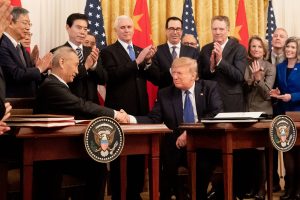On January 15, 2020, then-U.S. President Donald Trump welcomed China’s Vice Premier Liu He to the White House for the signing of the China-U.S. Economic and Trade Agreement, more commonly known as the “Phase One” trade deal. At the time, Trump hailed the agreement as “delivering a future of economic justice and security for American workers, farmers and families,” and his administration already had its sights set on a “phase two” of talks to address other issues, including tariffs, which remained largely untouched in the Phase One agreement.
At the same time, however, a new virus in Wuhan was capturing worldwide attention, despite China’s assurances on January 14, 2020 that there was “no clear evidence” of human-to-human transmission. Just six days after the Phase One deal was signed, COVID-19 – as it would come to be known – was first detected in the United States. On March 11, 2020 the WHO declared a global pandemic.
The COVID-19 pandemic not only upended global trade, thanks to border closures and factory-shuttering lockdowns, but took a wrecking ball to the fragile detente in China-U.S. relations. However, the Phase One deal remained in effect throughout and continues to shape China-U.S. trade relations today, with the Biden administration taking enforcement of the agreement as a starting point in its own negotiations with China.
Chad P. Bown, the Reginald Jones senior fellow at the Peterson Institute for International Economics, has been tracking fulfillment of the deal since it was announced in January 2020. The Diplomat interviewed Bown about how the agreement has been implemented, how it figures in China-U.S. trade relations, and what the Biden administration’s plan are for next steps.
The circumstances have changed dramatically since the Phase One deal was signed in January 2020. First came the COVID-19 pandemic, which altered the economic and trade environment; then there was a change in administrations in the U.S. With all that in mind, what role is the deal playing in China-U.S. trade relations today?
Even if not for the reasons initially expected, history is likely to judge the Phase One agreement as having played a fairly important role in U.S.-China trade relations over 2020-21.
The deal’s biggest payoff was likely that it halted escalating trade tensions between the U.S. and China. In the 18 months leading up to the agreement, each side had imposed new tariffs on more than half of its imports from the other; bilateral tariffs increased to an average of roughly 20 percent. While the deal did not end those tariffs, it stopped things from getting worse. No new tariffs were imposed in 2020-21.
The Phase One agreement also likely impacted the 2020 U.S. presidential campaign, but also not for the reasons initially anticipated. By very early in 2020, the trade data revealed that China was not making enough purchases to keep pace with the commitment to buy an additional $200 billion of U.S. exports. Phase One was therefore not something Trump would be able to highlight extensively while campaigning ahead of the November election.
For the incoming Biden administration, the agreement also meant there was no need to make immediate trade policy decisions on China upon assuming office in January 2021. They could get their trade team in place, assess the deal, resolve inherited bilateral grievances with the European Union and other allies, and then settle on their trade policy approach to China. That would take time – more so perhaps because of the pandemic – and the continuity of the Phase One agreement provided it.

































